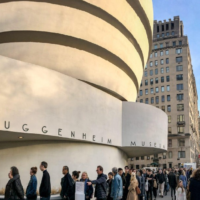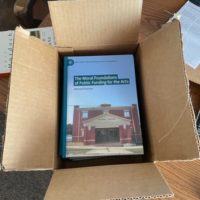New Yorkers who are interested in seeing the film Barbie at the local multiplex will pay $25.49 per ticket. If, on the same weekend, they wish to also see Oppenheimer, as I read, in about one hundred and forty-seven news reports, people were doing, then we are up to $51. If baseball is more your thing, $30.80 will put you in the highest tier right field bleachers to watch the rather mediocre Yankees take on the Tampa Bay Rays tonight. Many people will do these things. The New York Times reports on major big-city museums raising their single … [Read more...]
What’s Wrong with the Theatre is What’s Wrong With Society
In the New York Times, Isaac Butler sounds the alarm for the fate of live theatre in the US: The American theater is on the verge of collapse. ... Regional and nonprofit theaters were in trouble well before 2020 and the force majeure of the pandemic. Most regional and nonprofit theaters were built on a subscription model, in which loyal patrons paid for a full season of tickets upfront. Foundation grants, donations and single ticket sales made up the balance of the budgets. For much of the 20th century, this model worked. It locked … [Read more...]
Producing and exhibiting arts as a nonprofit entity is a qualified tax exempt activity
Here's what the Internal Revenue Service says: Organizations organized and operated exclusively for religious, charitable, scientific, testing for public safety, literary, educational, or other specified purposes and that meet certain other requirements are tax exempt under Internal Revenue Code Section 501(c)(3). Organizations whose primary focus is literary or educational are exempt from the corporate income tax (they are also typically exempt from state property taxes, but that is a state government matter). An orchestra or museum … [Read more...]
The real thing
For all the stages an author experiences in seeing the draft of a manuscript through edits and proofreads, nothing really matches the day you receive delivery of a box of hard copies. Details are here. The cover is a nod to the Hoosier state, who a hundred years ago or so decided that towns, even small ones, ought to have some place to gather to hear talks and enjoy performances. … [Read more...]
What classic movie best captures the USA right now? Breaking Away, obvs…
The New York Times asked 17 columnists to choose a single work. Maureen Dowd chose Invasion of the Body Snatchers, David French chose Arrival (great film, though I'm not entirely convinced as an answer to this question. But, and truly this is not hometown bias, the winner is a 1979 film that saw coming the divides that curse us in 2023. I reckon Mike is in his early 60s around now. … [Read more...]
Cultural Affairs: Bloomington is the place to be
The Center for Cultural Affairs at Indiana University in Bloomington is only four years old, but has quickly made a name for itself with conferences and a workshop series that brings together scholars and practitioners from around the world. This summer, the CCA hosts two in-person international conferences: The Association for Cultural Economics International will hold its biennial conference in Bloomington in late June. This is the first time I can recall when the conference has taken place in a small city. I first attended this … [Read more...]
Call for Papers – Cultural Policy and Cultural Democracy: A Global Dialogue – Santiago de Chile
The journal Cultural Trends (for which I serve on the Editorial Board) is hosting a wonderful event: The Cultural Trends journal team are hosting their first 'Global Dialogue' conference event in Santiago de Chile. Key themes (could) include: cultural democracy and social justice; power, public management and cultural policies; development of cultural institutions and governance of culture; subsidy for the arts and public financing alternatives; cultural worker, status of the artist and socioeconomic conditions of culture; the role of civil … [Read more...]
Who wants to go to college?
Should more young people go to college? This morning's papers presented very different answers to the question. The New York Times reports on President Biden's idea that we ought to ensure there are good and interesting careers and stable incomes for people who do not want to, or find it very difficult to, obtain a college degree: Mr. Biden’s approach is a shift from previous Democratic administrations, which were far more focused on college as a path to higher pay and advancement. Mr. Obama, during his first joint session of Congress, said … [Read more...]
Indirect price discrimination in theatre seats, books, and mummies
When arts presenters set prices, they know that there are some customers willing to pay top dollar for the highest quality offerings - the best seats in the house - while there are other potential customers who might have an interest in attending the show, but only at a lower price. The challenge in setting prices for different quality seats is that while we know there are different sorts of customers, some willing to pay a lot for high quality and others who are not, when a person comes to the box office window we cannot tell what sort of … [Read more...]
Strategic Planning and Muddling Through in the Arts
I'm at the stage of the semester where we begin our module on strategic planning. One of my favorite articles on the subject is from 1959, Charles Lindblom's "The Science of 'Muddling Through'", which takes abstract theorizing about ends and means down to the practical level of how plans are actually made in our world of organizations with histories, ways of doing things, and only limited information about the universe of possibilities; it could be thought of as something of an application of Michael Oakeshott's caution regarding "rationalism" … [Read more...]










